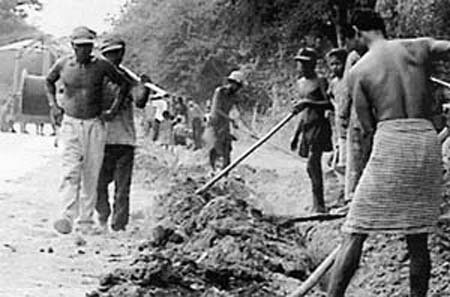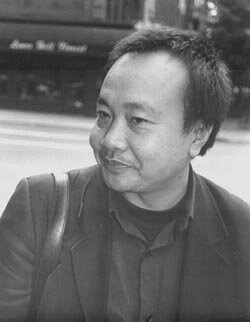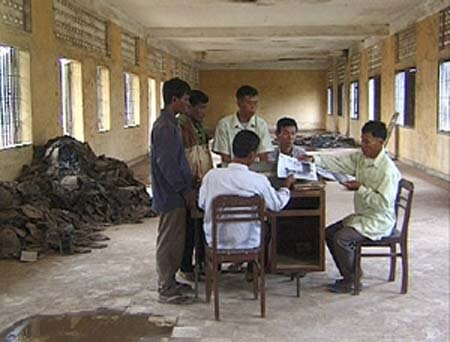![]()
COMING TO TERMS WITH THE PAST
The films of French Cambodian director Rithy Panh
by Caroline Herrick
|
In the documentary Bophana: A Cambodian Tragedy, a seventy-year-old woman with tears in her eyes somewhat bitterly states that she cannot understand why anyone would separate a husband and wife, as the Khmer Rouge separated her son and daughter-in-law, that she cannot understand that period and therefore cannot talk about it. During a discussion following a screening of the film at New York's Asia Society in May, the director, Rithy Panh, himself a survivor of the Khmer Rouge era, told a story about a young Cambodian girl, born in a refugee camp, who was growing up in France, the only Cambodian student in a French school. |
 |
|
Bophana: A Cambodian Tragedy |
Unlike the old woman in the film or the parents who had not found a way to explain to their daughter what had happened to their own parents, Rithy Panh feels compelled to explore the past in order to understand what happened to himself, his family, and his fellow countrymen, both the tortured and the torturers, "to confront memory rather than to flee it." But he did not always feel that way. Panh, who was born in Phnom Penh in 1964, was eleven years old when the Khmer Rouge entered the city on April 17, 1975, and evacuated its residents to collectives in the countryside, where they were to perform forced labor.He was separated from his familyboth of his parents were killed in the ensuing mayhemand lived in a "rehabilitation" camp from 1975 to 1979, when he escaped to a refugee camp in Thailand. The following year, he made his way to France, and in 1985, he was admitted to Institut des Hautes Etudes Cinématographiques in Paris, France's most prestigious film school. For a long time, he says, he did not want to talk about his experiences. And he thinks it is natural to want to forget, but adds that genocide is unnatural and impossible to forget. Then, at some point, he realized that "you need to make peace with the past in order to confront the future." For him, speaking about what had happened became imperativeboth to honor those who lost their lives and to come to terms with what he describes as "survivors' guilt," the nagging question that haunts most of those who lived through that era, why they survived when so many did not. Although he did not set out to become a filmmakerPanh says that if Pol Pot had not come to power, he would have become a teacher, like his father, or an astronaut, like Neil Armstrong, a childhood idolfilm was the medium he found most suited his purposes.
 |
| A scene from The Land of Wandering Souls |
Following his directorial debut with a short film in 1988, Panh has created a number of documentaries that, directly or indirectly, deal with the effects of the Khmer Rouge regime, whether the subject is life in a Cambodian refugee camp across the border in neighboring Thailand, as in Site II (1989), or the story of a young woman who was incarcerated in Phnom Penh's notorious Tuol Sleng prison and put to death in 1977, at the age of twenty-five, as in Bophana: A Cambodian Tragedy (1996), or migrant workers in the 1990s who are haunted by the bones of the dead and the land mines they uncover as they dig a trench across the countryside for a multinational corporation's transcontinental fiberoptic cable, as in The Land of Wandering Souls (1999). In addition, he has made two feature films, The Rice People (1994), adapted from a Malay novel, about the struggle for survival of a rice-farming family in a remote village, and One Evening After the War (1997), the story of a romance between a prostitute and a young Cambodian soldier who is returning to civilian life. Each of the films portrays people who live on the edge: the refugee-camp dwellers in Site II receive two rations of sugar a year and say they do not know how they would survive without the food rations provided by international humanitarian organizations; the migrant workers in The Land of Wandering Souls, whose meager wages are not enough to live on, shake ants from a branch to add protein to their soup; and in The Rice People, after the death of her husband, the mother of seven daughters goes mad, leaving the young girls to raise and harvest the rice crop by themselves. Tragic as the films are, each of them is suffused with the dignity of the individual. Panh does not idealize people, nor does he villainize them. The good exists along with the bad: an old woman shares what little food she has with a young migrant worker and her children, a foreman absconds with the payroll intended for his workers; neighbors help a family in distress, thieves pray upon the residents of a refugee camp.
Panh says he is not interested in making a political statement. An estimated 1.7 million peoplenearly a quarter of the populationwere killed in Cambodia during the Pol Pot years. But the magnitude of that calamity is not the subject of his films; what concerns him is each of the lives that was interrupted. Panh makes films about the individual, that explore how the individual confronts history, that allow the individual to speak. In Site II, it is the mother of a refugee family who describes how they got to the camp, what life is like there, and her hopes for her children. In Bophana, the voices of the young woman and her husband are allowed to speak through the letters they wrote to each other when they were parted, due to the Pol Pot regime, letters that incriminated them"in a country where love was an outrage to the revolutionary purity," as the film's narrator describes it and ultimately led to their deaths. Of the fifteen thousand to twenty thousand prisoners incarcerated in Tuol Sleng, there were only seven survivors, and two of themthe sculptor Im Chann and Vann Nath, the painter whose works are on display in the museum that the former prison houses todayappear in Bophana, describing their experiences, as does one of the former guards, named Huoy, who nervously relates how he led prisoners to their executions. And to make The Land of Wandering Souls, Panh's crew spent four months with the migrant workers, using two small video cameras to film them. As Panh describes it, when the workers were in the hot sun all day, we were in the hot sun all day, when they were in the water, we were in the water with them. The workers' conversations are recorded at such close range that viewers feel like they are sitting right beside them, listening in.
 |
The Land of Wandering Souls, which explores the relationship between modern technology and the people who contribute to making it possible but do not have access to it themselves, is the first of Panh's films to be made with a Cambodian crew. (In one scene, as two of the workers, who have been digging the trench with hoes, discuss the marvels of electronic communication, one wryly remarks,"I don't have electricity" and then goes on to say that he often doesn't have kerosene for his lamp.) One of Panh's concerns is the dominance of Western media and the notion that the records of our era are being created with one voice; the example he gives is of the number of satellite television stations that reach Cambodia today, none of which provides information that is particularly relevant to people's lives |
| Rithy Panh (photo by Caroline Herrick) |
To preserve the past and prepare for the future, Panh and a colleague are planning to create a cinémathèque in Phnom Penh, a center for the audiovisual arts. It will serve as a repository for film, sound, and photography archives, such as the rare black-and-white Khmer Rouge footage used in Bophana; as a center for research; and also as a school where Cambodians can receive training in filmmaking, broadcasting, sound recording, and photography. Panh feels that it is time to do something inside the country instead of sending students abroad to study. Right now he is working on fundraising for the center.
 |
| In S21, ex-torturers talk about a photograph of a prisoner who had committed suicide (Courtesy of Arte France - INA Photo) |
Although Panh's films have been widely distributed in Europe, both on television and in theaters, and have been critically acclaimed at film festivals the world over, they have rarely been seen in the United States. To date, there have been only a handful of public screenings here, two at college campuses, one at the Asia Society in New York, and one in Long Beach, California, where there is a large Cambodian population. The Land of Wandering Souls, was shown on PBS in 2002, but in a shortened version; the ninety-minute film was cut to fifty minutes, presumably to fit American time slotsand attention spans. However, perhaps this is about to change. Panh's latest film, S21: The Khmer Rouge Killing Machine, which was shown in a special presentation at Cannes this year, has been picked up by an American distributor, and it is anticipated that it will be shown at film festivals and theaters here. The film documents the memories of prisoners who were held at S21, as the Tuol Sleng prison was known, and those of their captors, building on the encounter between the survivor Vann Nath, and Huoy, the former prison guard, that took place in Bophana.
Although bringing those responsible for what happened during the Khmer Rouge era to justice is important, the question is how to do it. Where does one draw the line? As Panh points out, the United States and a number of other countries at one time recognized the Khmer Rouge regime. Panh says he would like to see the ten or twenty highest-ranking Khmer Rouge leaders who are still alive today put on trial. But he knows that, ultimately, a tribunal won't solve anything, it won't bring his parents back to life. What is more urgent is to help Cambodians work on their personal memories so that they can come to terms with the past. He hopes his films will be a jumping-off point for them to do just that. "It is a question of who we are, where we come from, how we explain ourselves to our children." And it is important not just for Cambodians, but for everyone.
Caroline Herrick is the editor of Persimmon.